NISSAN LATIO 2009 Service Repair Manual
Manufacturer: NISSAN, Model Year: 2009, Model line: LATIO, Model: NISSAN LATIO 2009Pages: 4331, PDF Size: 58.04 MB
Page 1691 of 4331
![NISSAN LATIO 2009 Service Repair Manual P0456 EVAP CONTROL SYSTEM
EC-335
< COMPONENT DIAGNOSIS >
[HR16DE] C
D E
F
G H
I
J
K L
M A EC
NP
O
P0456 EVAP CONTROL SYSTEM
DTC Logic INFOID:0000000004780206
DTC DETECTION LOGIC This diagnosis detects NISSAN LATIO 2009 Service Repair Manual P0456 EVAP CONTROL SYSTEM
EC-335
< COMPONENT DIAGNOSIS >
[HR16DE] C
D E
F
G H
I
J
K L
M A EC
NP
O
P0456 EVAP CONTROL SYSTEM
DTC Logic INFOID:0000000004780206
DTC DETECTION LOGIC This diagnosis detects](/img/5/57359/w960_57359-1690.png)
P0456 EVAP CONTROL SYSTEM
EC-335
< COMPONENT DIAGNOSIS >
[HR16DE] C
D E
F
G H
I
J
K L
M A EC
NP
O
P0456 EVAP CONTROL SYSTEM
DTC Logic INFOID:0000000004780206
DTC DETECTION LOGIC This diagnosis detects very small leaks in the EVAP line between fuel tank and EVAP canister purge volume
control solenoid valve, using the intake manifold vac uum in the same way as conventional EVAP small leak
diagnosis.
If ECM judges a leak which corresponds to a very small leak, the very small leak P0456 will be detected.
If ECM judges a leak equivalent to a small leak, EVAP small leak P0442 will be detected.
If ECM judges there are no leaks, the diagnosis will be OK.
CAUTION:
• Use only a genuine NISSAN fuel filler cap as a replacemen t. If an incorrect fuel filler cap is used, the
MIL may come on.
• If the fuel filler cap is not tigh tened properly, the MIL may come on.
DTC No. Trouble diagnosis name DTC detecting condition Possible cause
P0456 Evaporative emission
control system very
small leak (negative
pressure check) • EVAP system has a very small leak.
• EVAP system does not operate prop- erly. • Incorrect fuel tank vacuum relief valve
• Incorrect fuel filler cap used
• Fuel filler cap remains open or fails to close.
• Foreign matter caught in fuel filler cap.
• Leak is in line between intake manifold and EVAP
canister purge volume control solenoid valve.
• Foreign matter caught in EVAP canister vent con- trol valve.
• EVAP canister or fuel tank leaks
• EVAP purge line (pipe and rubber tube) leaks
• EVAP purge line rubber tube bent
• Loose or disconnected rubber tube
• EVAP canister vent control valve and the circuit
• EVAP canister purge volume control solenoid
valve and the circuit
• Fuel tank temperature sensor
• O-ring of EVAP canister vent control valve is miss-
ing or damaged
• EVAP canister is saturated with water
• EVAP control system pressure sensor
• Refueling EVAP vapor cut valve
• ORVR system leaks
• Fuel level sensor and the circuit
• Foreign matter caught in EVAP canister purge vol- ume control solenoid valve
• Drain filter PBIB1026E
Page 1692 of 4331
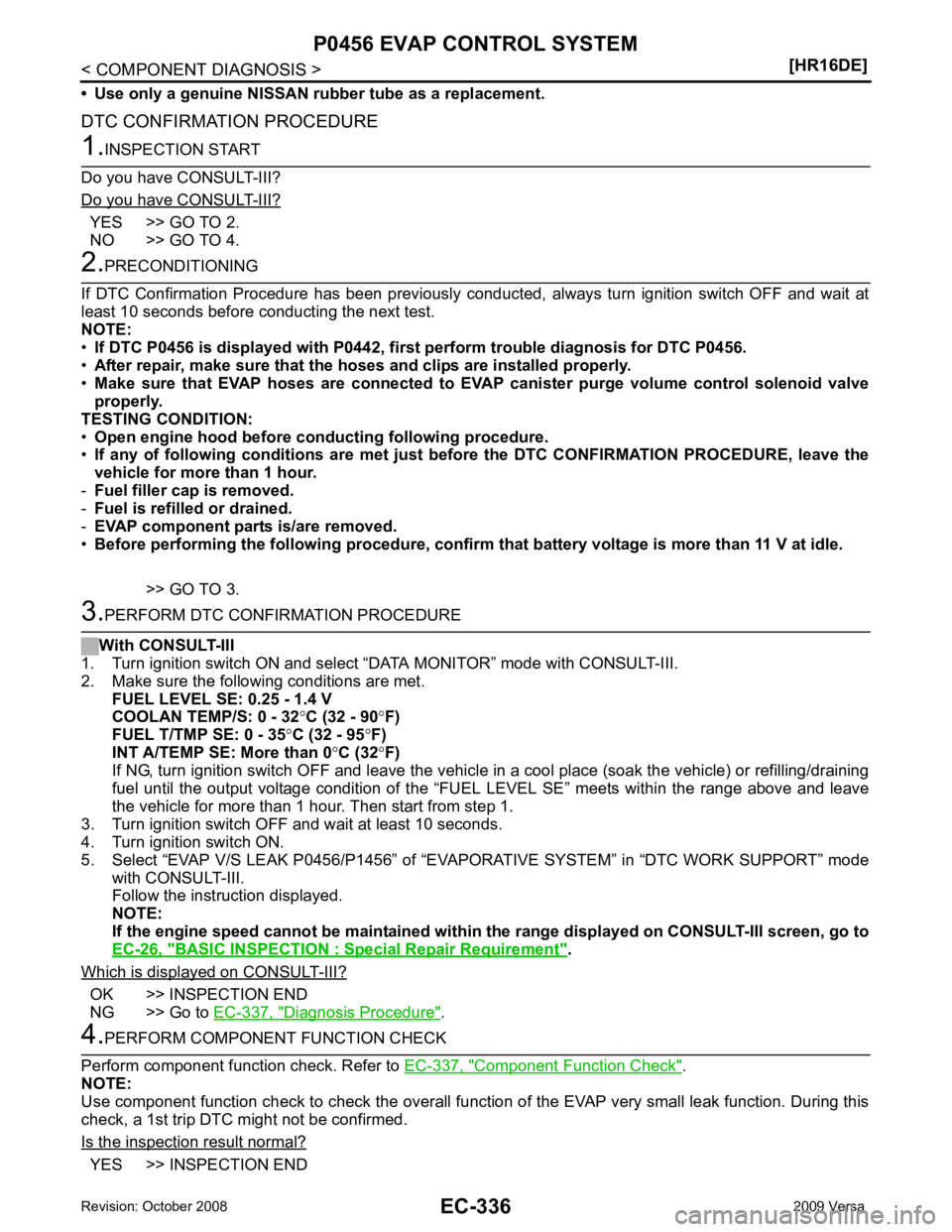
YES >> GO TO 2.
NO >> GO TO 4. BASIC INSPECTION : Special Repair Requirement " .
Which is displayed on CONSULT-III? OK >> INSPECTION END
NG >> Go to EC-337, " Diagnosis Procedure " .
Component Function Check " .
NOTE:
Use component function check to check the overall function of the EVAP very small leak function. During this
check, a 1st trip DTC might not be confirmed.
Is the inspection result normal? YES >> INSPECTION END
Page 1693 of 4331
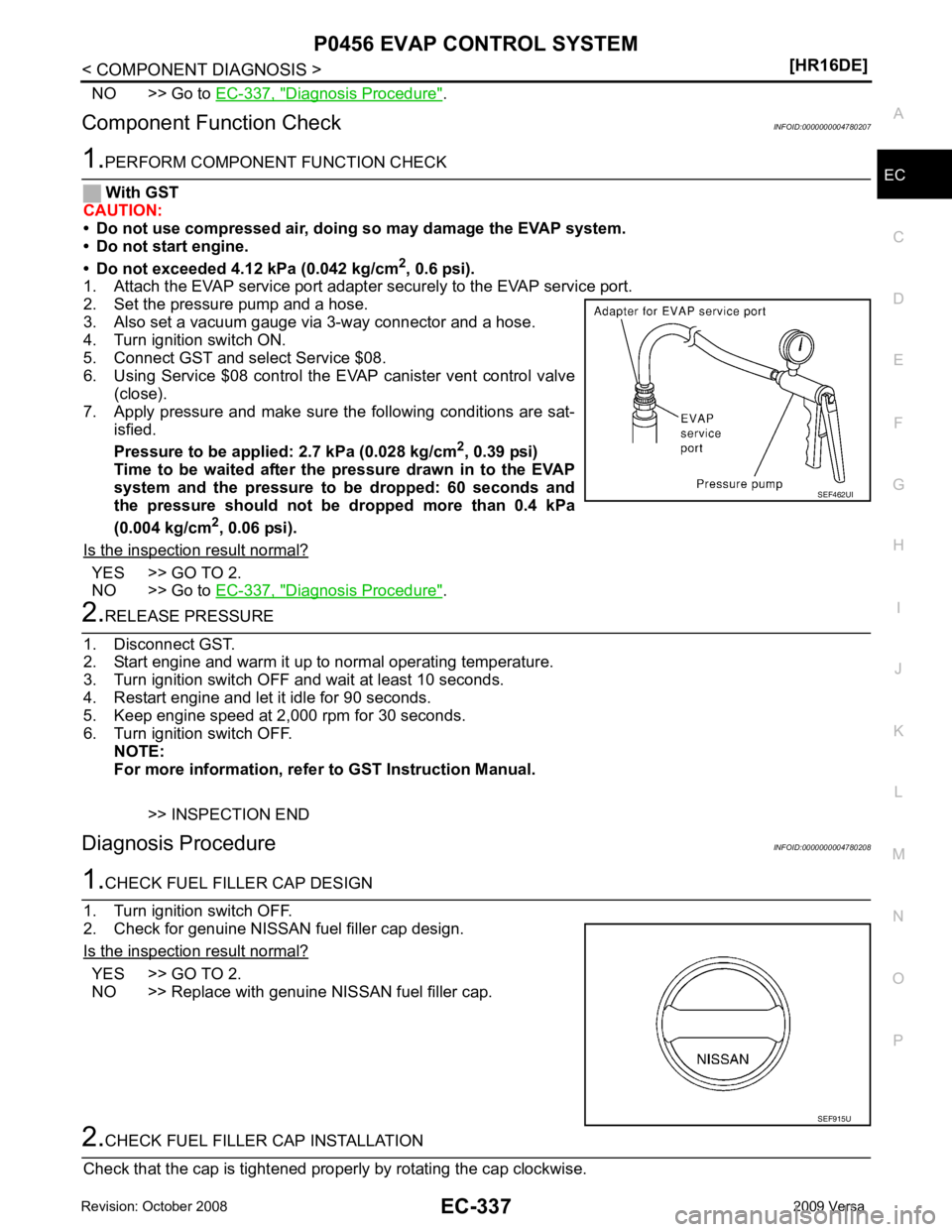
EC
NP
O
NO >> Go to
EC-337, " Diagnosis Procedure " .
Component Function Check INFOID:0000000004780207YES >> GO TO 2.
NO >> Go to EC-337, " Diagnosis Procedure " .
YES >> GO TO 2.
NO >> Replace with genuine NISSAN fuel filler cap. SEF915U
Page 1694 of 4331
![NISSAN LATIO 2009 Service Repair Manual EC-338< COMPONENT DIAGNOSIS >
[HR16DE]
P0456 EVAP CONTROL SYSTEM
Is the inspection result normal? YES >> GO TO 3.
NO >> Open fuel filler cap, then clean cap and fuel filler neck threads us NISSAN LATIO 2009 Service Repair Manual EC-338< COMPONENT DIAGNOSIS >
[HR16DE]
P0456 EVAP CONTROL SYSTEM
Is the inspection result normal? YES >> GO TO 3.
NO >> Open fuel filler cap, then clean cap and fuel filler neck threads us](/img/5/57359/w960_57359-1693.png)
EC-338< COMPONENT DIAGNOSIS >
[HR16DE]
P0456 EVAP CONTROL SYSTEM
Is the inspection result normal? YES >> GO TO 3.
NO >> Open fuel filler cap, then clean cap and fuel filler neck threads using air blower. Then retighten
until ratcheting sound is heard. 3.
CHECK FUEL FILLER CAP FUNCTION
Check for air releasing sound while opening the fuel filler cap.
Is the inspection result normal? YES >> GO TO 5.
NO >> GO TO 4. 4.
CHECK FUEL TANK VACUUM RELIEF VALVE
Refer to EC-340, " Component Inspection (Fuel filler cap) " .
Is the inspection result normal? YES >> GO TO 5.
NO >> Replace fuel filler cap with a genuine one. 5.
CHECK FOR EVAP LEAK
Refer to EC-500, " Inspection " .
Is there any leak in EVAP line? YES >> Repair or replace.
NO >> GO TO 6. 6.
CHECK DRAIN FILTER
Refer to EC-341, " Component Inspection (Drain filter) " .
Is the inspection result normal? YES >> GO TO 7.
NO >> Replace drain filter. 7.
CHECK EVAP CANISTER VENT CONTROL VALVE
Check the following.
• EVAP canister vent control valve is installed properly.
Refer to EC-502, " Exploded View " .
• EVAP canister vent control valve. Refer to EC-304, " Component Inspection " .
Is the inspection result normal? YES >> GO TO 8.
NO >> Repair or replace EVAP cani ster vent control valve and O-ring.8.
CHECK IF EVAP CANISTER IS SATURATED WITH WATER
1. Remove EVAP canister with EVAP canister vent control valve and EVAP control system pressure sensor
attached.
2. Check if water will drain from the EVAP canister.
Does water drain from EVAP canister? YES >> GO TO 9.
NO-1 >> With CONSULT-III: GO TO 11.
NO-2 >> Without CONSULT-III: GO TO 12. 9.
CHECK EVAP CANISTER
Weigh the EVAP canister with the EVAP canister vent control valve and EVAP control system pressure sensor
attached.
The weight should be less than 1.9 kg (4.2 lb). PBIB1213E
Page 1695 of 4331
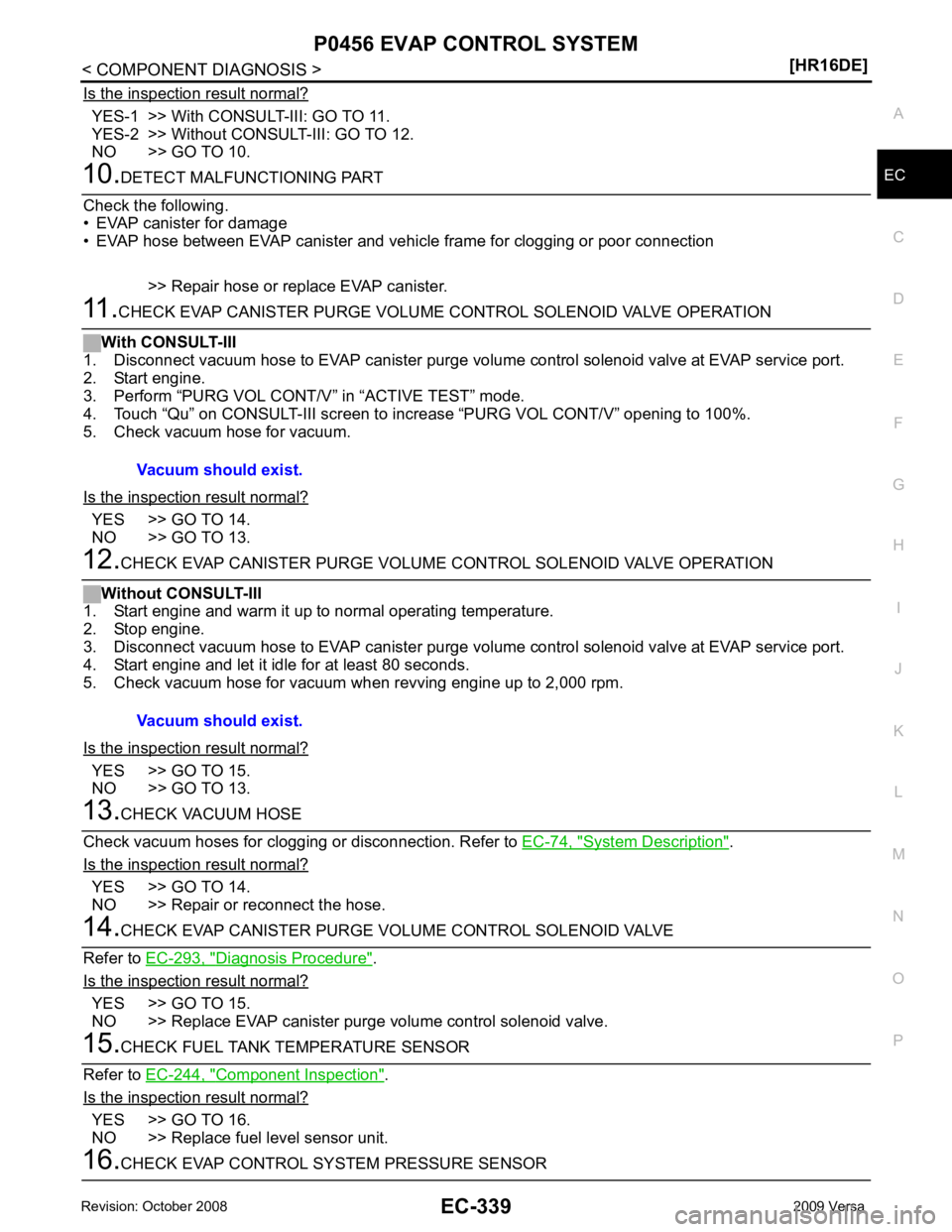
EC
NP
O
Is the inspection result normal? YES-1 >> With CONSULT-III: GO TO 11.
YES-2 >> Without CONSULT-III: GO TO 12.
NO >> GO TO 10. YES >> GO TO 14.
NO >> GO TO 13. YES >> GO TO 15.
NO >> GO TO 13. System Description " .
Is the inspection result normal? YES >> GO TO 14.
NO >> Repair or reconnect the hose. Diagnosis Procedure " .
Is the inspection result normal? YES >> GO TO 15.
NO >> Replace EVAP canister purge volume control solenoid valve. Component Inspection " .
Is the inspection result normal? YES >> GO TO 16.
NO >> Replace fuel level sensor unit. Vacuum should exist.
Page 1696 of 4331
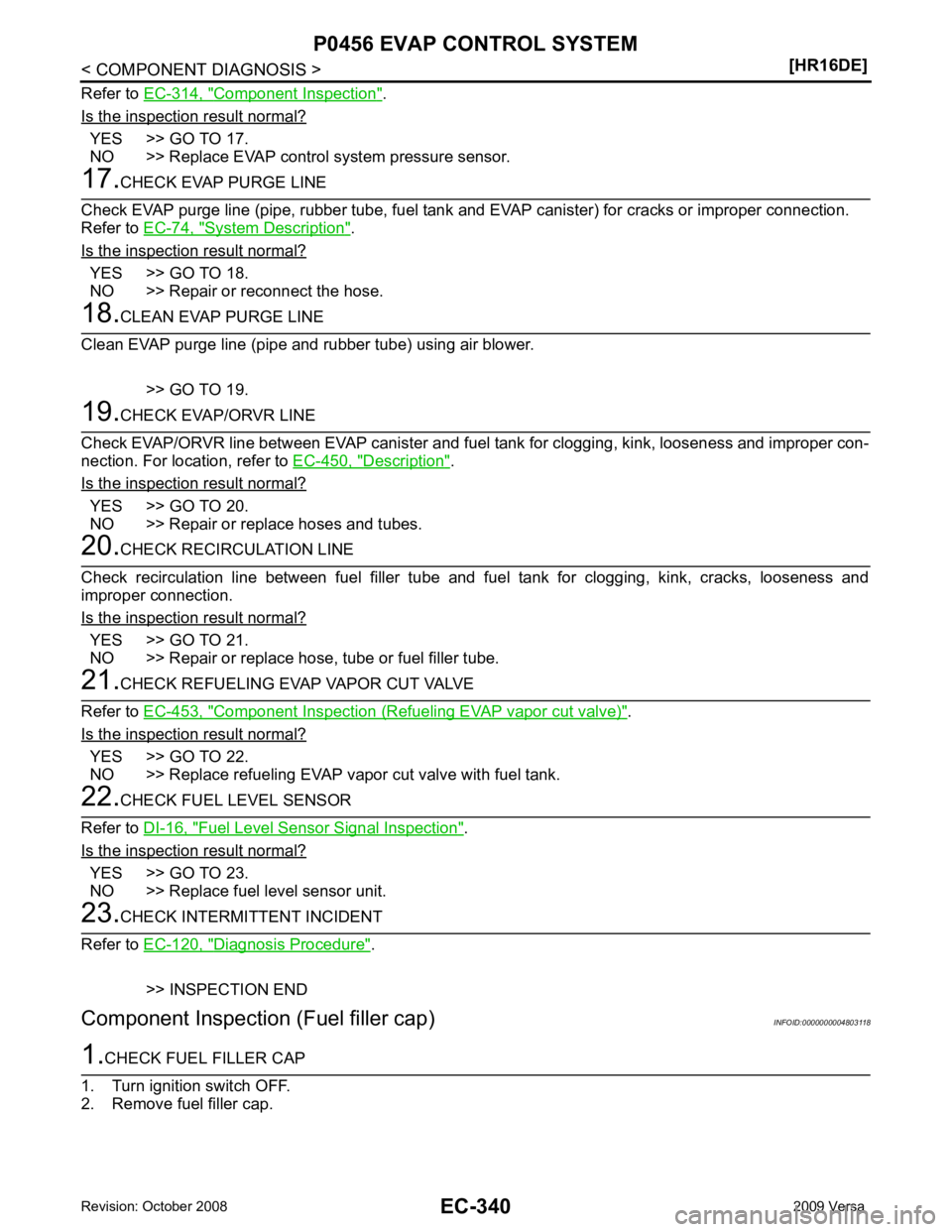
Component Inspection " .
Is the inspection result normal? YES >> GO TO 17.
NO >> Replace EVAP control system pressure sensor. System Description " .
Is the inspection result normal? YES >> GO TO 18.
NO >> Repair or reconnect the hose. Description " .
Is the inspection result normal? YES >> GO TO 20.
NO >> Repair or replace hoses and tubes. YES >> GO TO 21.
NO >> Repair or replace hose, tube or fuel filler tube. Component Inspection (Refueli
ng EVAP vapor cut valve) " .
Is the inspection result normal? YES >> GO TO 22.
NO >> Replace refueling EVAP vapor cut valve with fuel tank. Fuel Level Sensor Signal Inspection " .
Is the inspection result normal? YES >> GO TO 23.
NO >> Replace fuel level sensor unit. Diagnosis Procedure " .
>> INSPECTION END
Component Inspection (Fuel filler cap) INFOID:0000000004803118
Page 1697 of 4331
![NISSAN LATIO 2009 Service Repair Manual P0456 EVAP CONTROL SYSTEM
EC-341
< COMPONENT DIAGNOSIS >
[HR16DE] C
D E
F
G H
I
J
K L
M A EC
NP
O
3. Wipe clean valve housing.
4. Install fuel filler cap adapter (commercial service tool) to NISSAN LATIO 2009 Service Repair Manual P0456 EVAP CONTROL SYSTEM
EC-341
< COMPONENT DIAGNOSIS >
[HR16DE] C
D E
F
G H
I
J
K L
M A EC
NP
O
3. Wipe clean valve housing.
4. Install fuel filler cap adapter (commercial service tool) to](/img/5/57359/w960_57359-1696.png)
P0456 EVAP CONTROL SYSTEM
EC-341
< COMPONENT DIAGNOSIS >
[HR16DE] C
D E
F
G H
I
J
K L
M A EC
NP
O
3. Wipe clean valve housing.
4. Install fuel filler cap adapter (commercial service tool) to fuel filler cap.
5. Check valve opening pressure and vacuum.
Is the inspection result normal? YES >> INSPECTION END
NO >> GO TO 2. 2.
REPLACE FUEL FILLER CAP
Replace fuel filler cap.
CAUTION:
Use only a genuine fuel filler cap as a replacement. If an incorrect fuel filler cap is used, the MIL may
illuminate.
>> INSPECTION END
Component Inspection (Drain filter) INFOID:00000000048030971.
CHECK DRAIN FILTER
1. Check visually for insect nests in the drain filter air inlet.
2. Check visually for cracks or flaws in the appearance.
3. Check visually for cracks or flaws in the hose.
4. Blow air into port A and check that it flows freely out of port B.
5. Block port B.
6. Blow air into port A and check that there is no leakage.
Is the inspection result normal? YES >> INSPECTION END
NO >> Replace drain filter. SEF445Y
Pressure:
15.3 - 20.0 kPa (0.156 - 0.204 kg/cm 2
, 2.22 -
2.90 psi)
Vacuum: −6.0 to −3.3 kPa ( −0.061 to −0.034 kg/cm 2
,
− 0.87 to −0.48 psi) SEF943S
PBIB3641E
Page 1698 of 4331
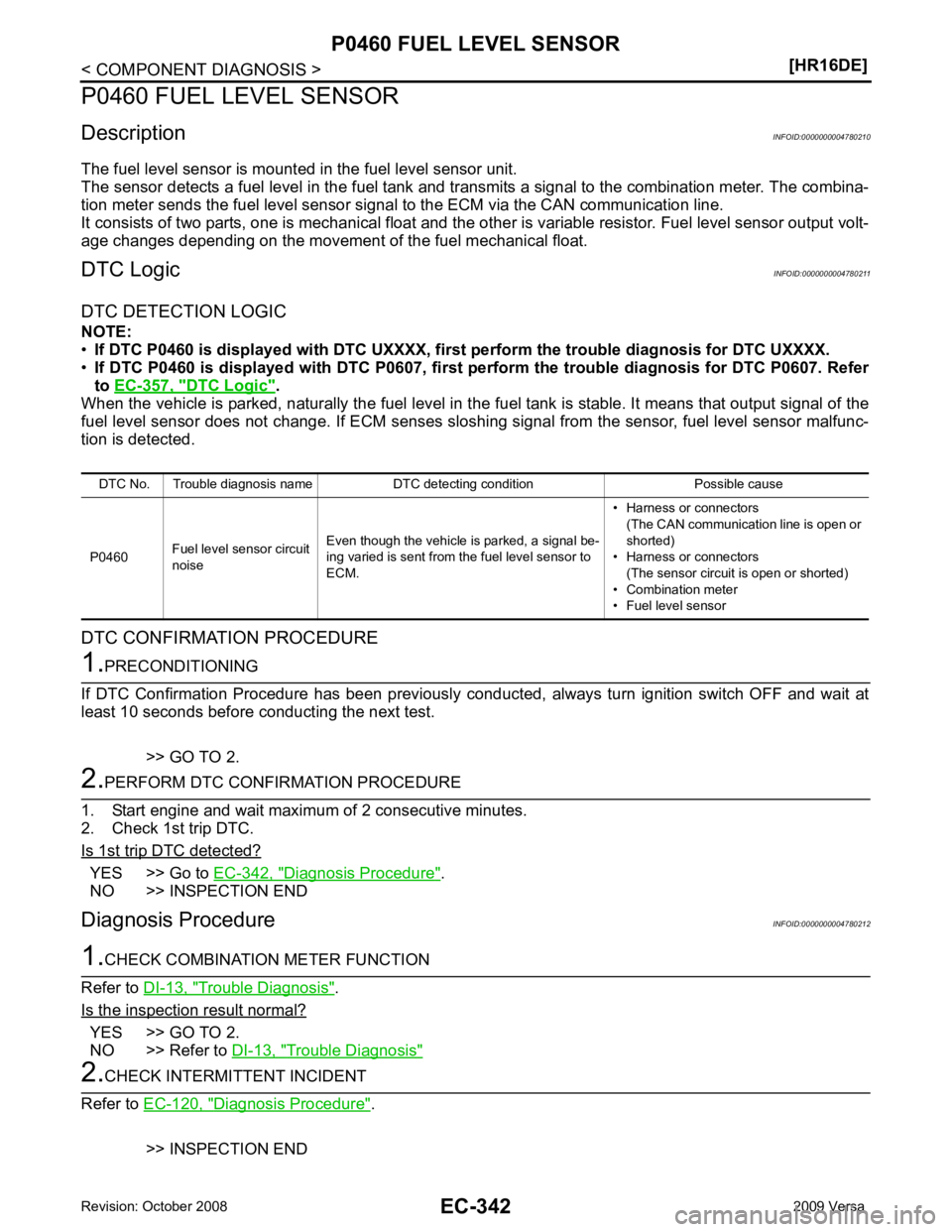
DTC Logic " .
When the vehicle is parked, naturally the fuel level in the fuel tank is stable. It means that output signal of the
fuel level sensor does not change. If ECM senses sloshi ng signal from the sensor, fuel level sensor malfunc-
tion is detected.
DTC CONFIRMATION PROCEDURE YES >> Go to
EC-342, " Diagnosis Procedure " .
NO >> INSPECTION END
Diagnosis Procedure INFOID:0000000004780212Trouble Diagnosis " .
Is the inspection result normal? YES >> GO TO 2.
NO >> Refer to DI-13, " Trouble Diagnosis "
Diagnosis Procedure " .
>> INSPECTION END
DTC No. Trouble diagnosis name DTC detecting condition Possible cause
P0460 Fuel level sensor circuit
noise Even though the vehicle is parked, a signal be-
ing varied is sent from the fuel level sensor to
ECM. • Harness or connectors
(The CAN communication line is open or
shorted)
• Harness or connectors
(The sensor circuit is open or shorted)
• Combination meter
• Fuel level sensor
Page 1699 of 4331
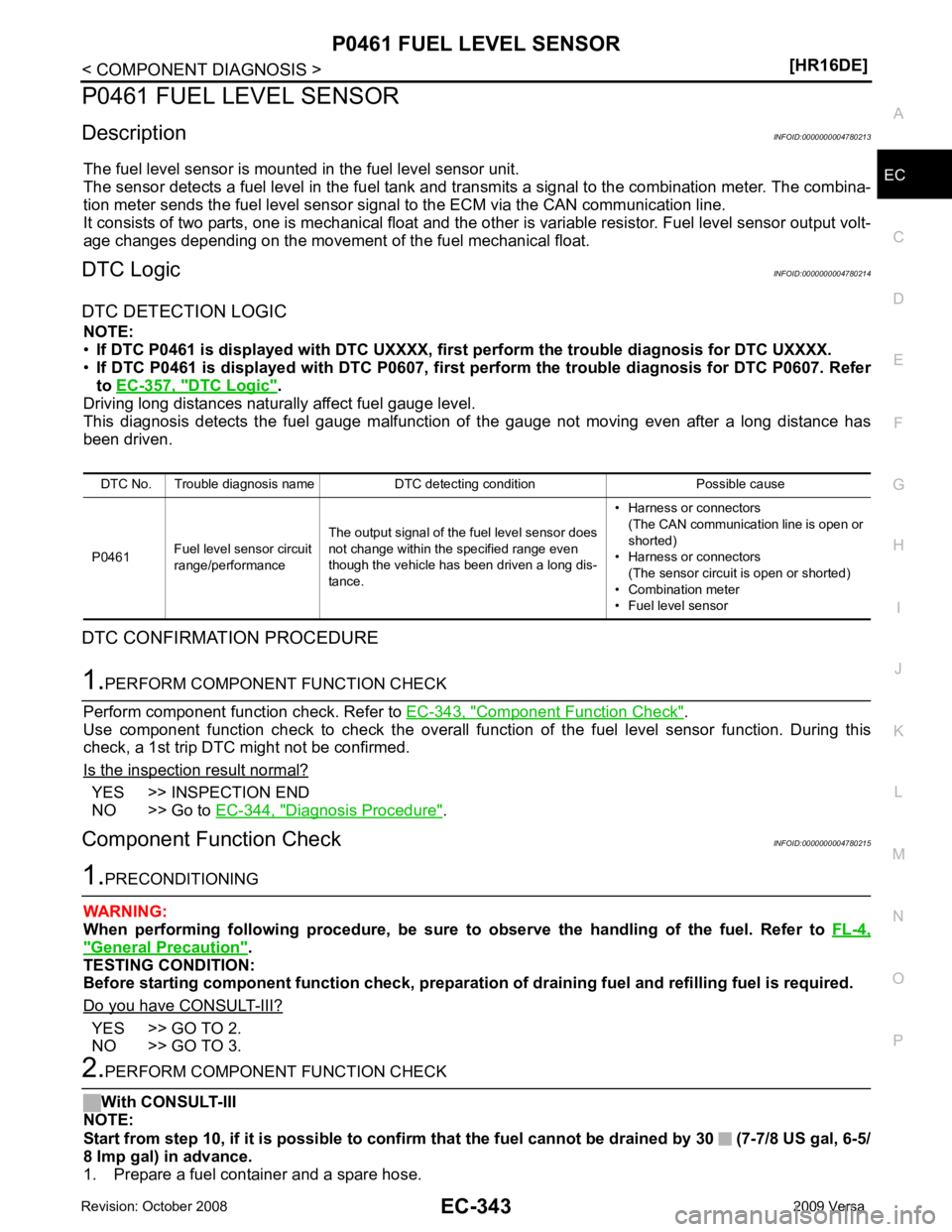
EC
NP
O
P0461 FUEL LEVEL SENSOR
Description INFOID:0000000004780213
The fuel level sensor is mounted in the fuel level sensor unit.
The sensor detects a fuel level in the fuel tank and tr ansmits a signal to the combination meter. The combina-
tion meter sends the fuel level sensor signal to the ECM via the CAN communication line.
It consists of two parts, one is mechanical float and the ot her is variable resistor. Fuel level sensor output volt-
age changes depending on the movement of the fuel mechanical float.
DTC Logic INFOID:0000000004780214
DTC DETECTION LOGIC NOTE:
• If DTC P0461 is displayed with DTC UXXXX, first perform the tr ouble diagnosis for DTC UXXXX.
• If DTC P0461 is displayed with DT C P0607, first perform the trouble diagnosis for DTC P0607. Refer
to EC-357, " DTC Logic " .
Driving long distances naturally affect fuel gauge level.
This diagnosis detects the fuel gauge malfunction of the gauge not moving even after a long distance has
been driven.
DTC CONFIRMATION PROCEDURE Component Function Check " .
Use component function check to check the overall func tion of the fuel level sensor function. During this
check, a 1st trip DTC might not be confirmed.
Is the inspection result normal? YES >> INSPECTION END
NO >> Go to EC-344, " Diagnosis Procedure " .
Component Function Check INFOID:0000000004780215" General Precaution " .
TESTING CONDITION:
Before starting component function check, preparation of draining fuel and refilling fuel is required.
Do you have CONSULT-III? YES >> GO TO 2.
NO >> GO TO 3.
Page 1700 of 4331
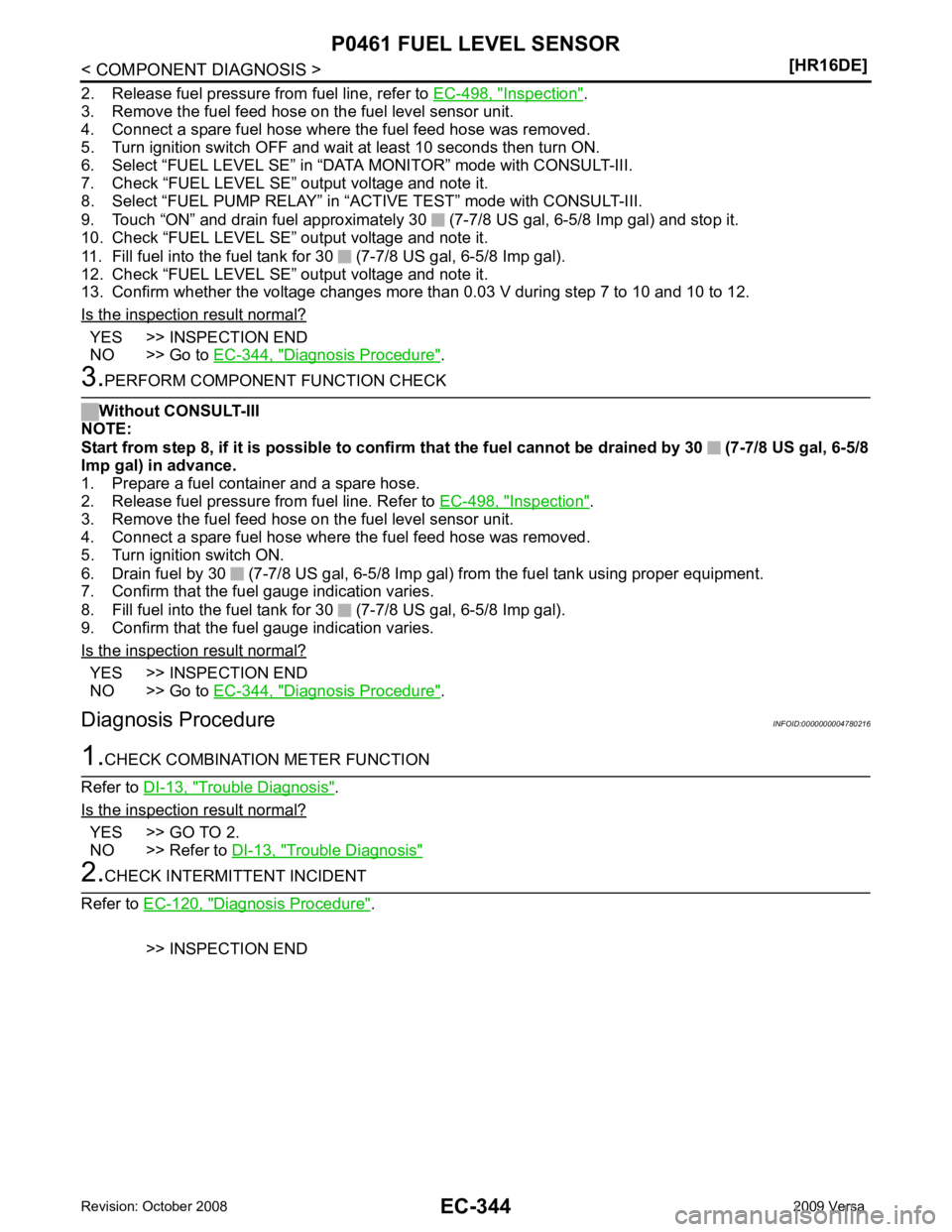
Inspection " .
3. Remove the fuel feed hose on the fuel level sensor unit.
4. Connect a spare fuel hose where the fuel feed hose was removed.
5. Turn ignition switch OFF and wait at least 10 seconds then turn ON.
6. Select “FUEL LEVEL SE” in “DAT A MONITOR” mode with CONSULT-III.
7. Check “FUEL LEVEL SE” output voltage and note it.
8. Select “FUEL PUMP RELAY” in “ACTIVE TEST” mode with CONSULT-III.
9. Touch “ON” and drain fuel approximately 30 (7-7/8 US gal, 6-5/8 Imp gal) and stop it.
10. Check “FUEL LEVEL SE” output voltage and note it.
11. Fill fuel into the fuel tank for 30 (7-7/8 US gal, 6-5/8 Imp gal).
12. Check “FUEL LEVEL SE” output voltage and note it.
13. Confirm whether the voltage changes more than 0.03 V during step 7 to 10 and 10 to 12.
Is the inspection result normal? YES >> INSPECTION END
NO >> Go to EC-344, " Diagnosis Procedure " .
Inspection " .
3. Remove the fuel feed hose on the fuel level sensor unit.
4. Connect a spare fuel hose where the fuel feed hose was removed.
5. Turn ignition switch ON.
6. Drain fuel by 30 (7-7/8 US gal, 6-5/8 Imp gal) from the fuel tank using proper equipment.
7. Confirm that the fuel gauge indication varies.
8. Fill fuel into the fuel tank for 30 (7-7/8 US gal, 6-5/8 Imp gal).
9. Confirm that the fuel gauge indication varies.
Is the inspection result normal? YES >> INSPECTION END
NO >> Go to EC-344, " Diagnosis Procedure " .
Diagnosis Procedure INFOID:0000000004780216Trouble Diagnosis " .
Is the inspection result normal? YES >> GO TO 2.
NO >> Refer to DI-13, " Trouble Diagnosis "
Diagnosis Procedure " .
>> INSPECTION END